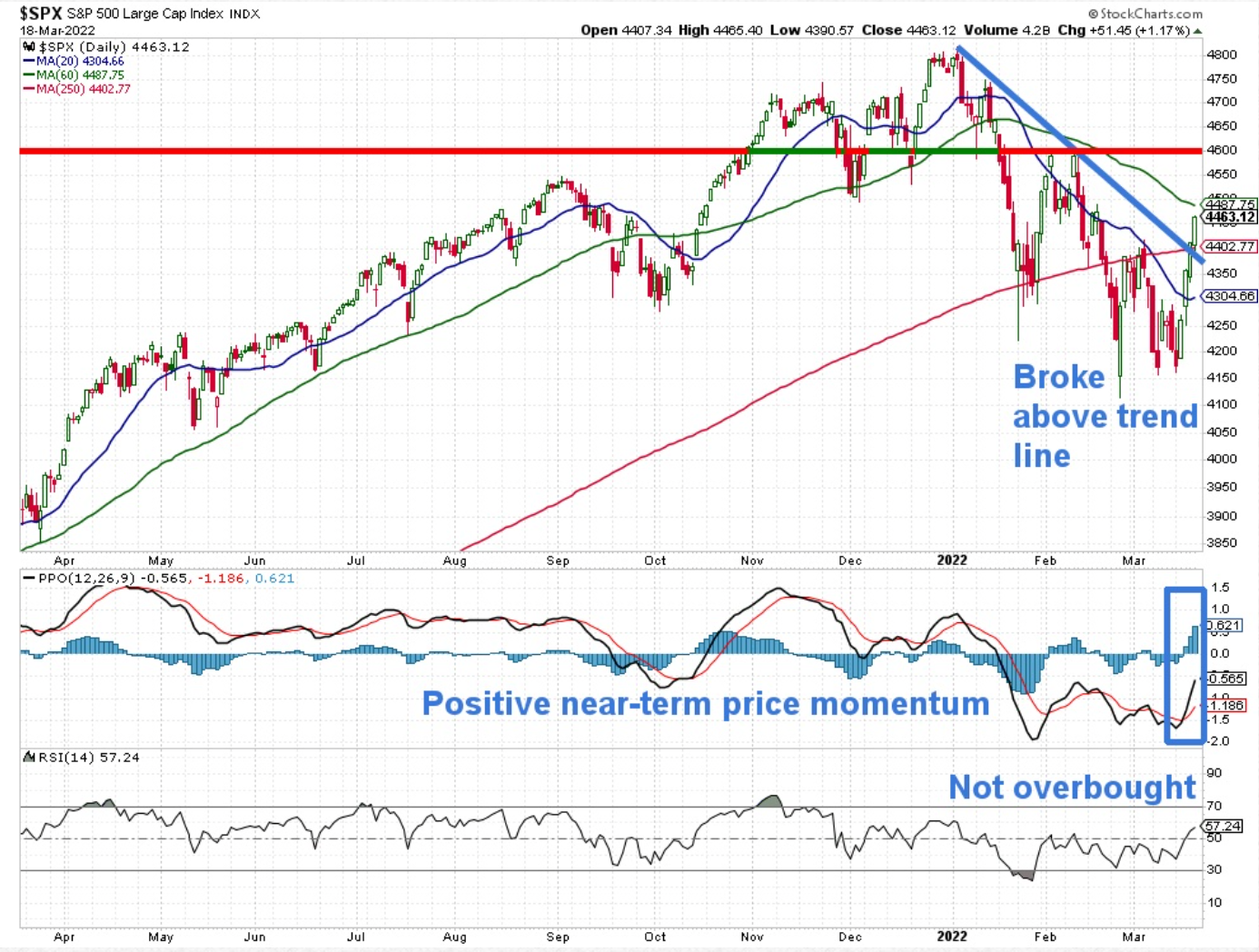Stocks are up almost 9% from their March 14 bottom. But according to Jon Wolfenbarger, many of the market’s technical indicators are still bearish. He warned that the recent reversal could be a “bear market rally.” After falling 13% to start the year, the S&P 500 has rallied over the last two weeks to close Friday down 6% from record highs.
If you’re an investor, the question you’re likely asking yourself at the moment is: should I continue to buy the dip?
In the near-term, doing so can feel like a risky bet. The Federal Reserve is just getting started on its tightening regime. Ongoing geopolitical tensions also continue to cast uncertainty on growth prospects. And 40-year-high inflation is denting consumer confidence.
Here’s a chart LPL Financial published this week showing discretionary consumer spending continuing to stall below pre-pandemic levels.
LPL Financial On the other hand, all of those negatives have already weighed on investors’ outlooks, and are therefore priced in to some degree. So an improving situation for any one of those factors may fuel the market higher.
If you ask Jon Wolfenbarger, the founder of BullandBearProfits.com and a former Allianz Global Investors securities analyst, the timing doesn’t look quite right yet, despite the recent rally.
In a March 20 commentary, Wolfenbarger laid out a slew of technical indicators that show stocks are still in their bearish trend, and the recent reversal is a ” bear market rally.” Technical analysis is the examination of price and trading volume trends — absent fundamentals like valuations, earnings, and macroeconomic trends — to try to anticipate near-term price action.
One technical indicator Wolfenbarger is looking at is the S&P 500’s daily moving averages. He defines a technical bear market as when an index’s 20-day and 60-day moving averages — as well as its current price — all sit below the gauge’s longer-term 250-day moving average.
The S&P 500’s 20-day moving average is currently below its 250-day moving average, but its price level recently broke above its 250-day moving average again. But Wolfenbarger pointed out that its 60-day moving average is still falling and hasn’t yet bottomed.
More to that point, while near-term price momentum is positive, Wolfenbarger pointed out that the S&P 500’s relative strength index (RSI) — which measures overbought and oversold conditions — wasn’t in oversold territory when the recent rally began. He said this can be a sign of a more significant bottom. At the same time, the index is also currently not overbought.
Bullandbearprofits.com Adding to the bearish evidence, Wolfenbarger highlighted that on two days last week where stocks closed positive, volume of shares traded dropped. He called this “typical of bear market rallies.”
“Friday volume surged due to the ‘triple witching’ options expirations (options expired on single stocks, futures on stock indexes and options on stock indexes), but up volume was only 68.1% of total volume, which is somewhat tepid given the strong price action,” he said, referring to the March 18 session. The index close up 1.17% that day.
Wolfenbarger also said that while near-term momentum is positive, as shown in the chart above, longer-term price momentum — weekly and monthly measures — are still headed downward.
And then there’s the fact that the S&P 500 remains the only major group of stocks (among other passive funds) not in a technical bear market. According to Wolfenbarger, funds whose price levels and 20-day and 60-day moving averages are below their 250-day moving averages include: The Invesco QQQ Trust, the Vanguard Total World Stock Fund, the Vanguard Developed Markets Index Fund , the Vanguard Small-Cap Index Fund, and others.
Further, volatility trends show that longer-term stock market volatility is rising, which Wolfenbarger said is bearish for longer-term returns. Still, volatility has fallen in the near-term.
Bullandbearprofits.com Finally, Wolfenbarger highlighted that professional money managers are still holding back from buying, and that large percentages of stocks on both the New York Stock Exchange and the Nasdaq are still trading below their 200-day moving averages. As of last week, 43.5% of stocks listed on the NYSE and 24% of stocks on the Nasdaq are trading below their 200-day moving averages, Wolfenbarger said.
The bigger pictureWolfenbarger puts together a compelling list of warning signs that investors ought to be monitoring in the weeks ahead.
At the same time, it’s important to watch fundamentals and developments in the market as well.
Investors are sitting in a pool of uncertainty heading into the second quarter of 2022. This stems from uncertainty in the macroeconomic outlook, as the Fed prepares to step on the monetary tightening gas pedal in the months ahead too cool off prices rising at a speed not seen since the early 1980s.
Despite strong job growth and wage gains, many are beginning to expect a recession later this year. Acclaimed economist David Rosenberg told Insider recently that he sees a 75% chance of a recession in 2022. Wells Fargo puts that probability at 50%, and Goldman Sachs at 40%.
Danielle DiMartino Booth, a former advisor at the Federal Reserve , told Insider in March that she thinks the Fed has essentially no choice but to cause a recession in order to slow down inflation.
“I think they’re going to keep going until something breaks,” she said. “And right now nothing’s broken, except for inflation.”
Fed Chair Jay Powell, however, said he doesn’t anticipate the bank’s monetary policy will trigger a recession this year.
The median price target for the S&P 500 in 2022 among top Wall Street strategists is around 4,900. That’s about 7.8% higher than current levels.
Stocks may indeed still have upside, but as gas prices remain elevated, and as the Fed gets ready to aggressively pull money out of financial markets and hike interest rates, investors would do well to approach the current environment with caution.
